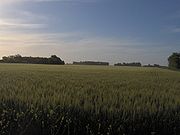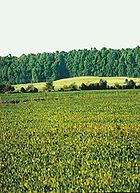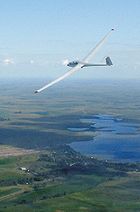
Humid Pampa
Encyclopedia

Grassland
Grasslands are areas where the vegetation is dominated by grasses and other herbaceous plants . However, sedge and rush families can also be found. Grasslands occur naturally on all continents except Antarctica...
of loess
Loess
Loess is an aeolian sediment formed by the accumulation of wind-blown silt, typically in the 20–50 micrometre size range, twenty percent or less clay and the balance equal parts sand and silt that are loosely cemented by calcium carbonate...
ic origin in Argentina
Argentina
Argentina , officially the Argentine Republic , is the second largest country in South America by land area, after Brazil. It is constituted as a federation of 23 provinces and an autonomous city, Buenos Aires...
. It has a precipitation average of 900 mm per year, in contrast with the Dry Pampa
Semi-arid Pampas
The Semi-arid Pampas, also known as the Dry Pampas, is a temperate grassland ecoregion of central Argentina.-Setting:The Semi-arid Pampas cover an area of , including western Buenos Aires Province, southern Cordoba and San Luis Provinces and most of La Pampa Province...
s to the west, which average less than 700 mm.
Setting

Mollisols
Mollisols are a soil order in USDA soil taxonomy. Mollisols form in semi-arid to semi-humid areas, typically under a grassland cover. They are most commonly found in the mid-latitudes, namely in North America, mostly east of the Rocky Mountains, in South America in Argentina and Brazil, and in...
are more abundant here than to the west, where soils of loess
Loess
Loess is an aeolian sediment formed by the accumulation of wind-blown silt, typically in the 20–50 micrometre size range, twenty percent or less clay and the balance equal parts sand and silt that are loosely cemented by calcium carbonate...
ic origin are more common. Except for a few bluffs
Cliff
In geography and geology, a cliff is a significant vertical, or near vertical, rock exposure. Cliffs are formed as erosion landforms due to the processes of erosion and weathering that produce them. Cliffs are common on coasts, in mountainous areas, escarpments and along rivers. Cliffs are usually...
near the Paraná
Paraná River
The Paraná River is a river in south Central South America, running through Brazil, Paraguay and Argentina for some . It is second in length only to the Amazon River among South American rivers. The name Paraná is an abbreviation of the phrase "para rehe onáva", which comes from the Tupi language...
and Río de la Plata
Río de la Plata
The Río de la Plata —sometimes rendered River Plate in British English and the Commonwealth, and occasionally rendered [La] Plata River in other English-speaking countries—is the river and estuary formed by the confluence of the Uruguay River and the Paraná River on the border between Argentina and...
rivers, as well as the Ventana Sierras to the south, the region's slope rarely exceeds 6 degrees. It covers Buenos Aires Province
Buenos Aires Province
The Province of Buenos Aires is the largest and most populous province of Argentina. It takes the name from the city of Buenos Aires, which used to be the provincial capital until it was federalized in 1880...
almost completely, the centre and south of Santa Fe Province
Santa Fe Province
The Invincible Province of Santa Fe, in Spanish Provincia Invencible de Santa Fe , is a province of Argentina, located in the center-east of the country. Neighboring provinces are from the north clockwise Chaco , Corrientes, Entre Ríos, Buenos Aires, Córdoba, and Santiago del Estero...
, most of Córdoba Province
Córdoba Province (Argentina)
Córdoba is a province of Argentina, located in the center of the country. Neighboring provinces are : Santiago del Estero, Santa Fe, Buenos Aires, La Pampa, San Luis, La Rioja and Catamarca...
and the eastern third of La Pampa Province
La Pampa Province
La Pampa is a sparsely populated province of Argentina, located in the Pampas in the center of the country. Neighboring provinces are from the north clockwise San Luis, Córdoba, Buenos Aires, Río Negro, Neuquén and Mendoza.-History:...
, totalling at least 600,000 km².
The Uruguayan savanna
Uruguayan savanna
The Uruguayan savanna, also known as the Brazilian-Uruguayan savanna, is a subtropical grassland and savanna ecoregion which includes all of Uruguay, some areas of northeastern Argentina and southernmost Brazil.-Flora:...
, which lies east of these rivers in Entre Ríos Province
Entre Ríos Province
Entre Ríos is a northeastern province of Argentina, located in the Mesopotamia region. It borders the provinces of Buenos Aires , Corrientes and Santa Fe , and Uruguay in the east....
of Argentina, Uruguay
Uruguay
Uruguay ,officially the Oriental Republic of Uruguay,sometimes the Eastern Republic of Uruguay; ) is a country in the southeastern part of South America. It is home to some 3.5 million people, of whom 1.8 million live in the capital Montevideo and its metropolitan area...
and the south of Brazil
Brazil
Brazil , officially the Federative Republic of Brazil , is the largest country in South America. It is the world's fifth largest country, both by geographical area and by population with over 192 million people...
, is sometimes considered part of the Humid Pampa. The Uruguayan savanna is not as flat as the named aforementioned areas.
The flatlands are also interrupted by formations of low hills in a few places in the west, namely near Balcarce
Balcarce, Buenos Aires
-External links:...
, Olavarría
Olavarría
Olavarría is a city in the province of Buenos Aires, Argentina, located. It is the capital of the Olavarría Partido and has over 111,320 inhabitants, per the ....
, Tandil
Tandil
-Place name:The name of the city comes from the Mapuche words tan , and lil . It is probably a reference to the Piedra Movediza , a large boulder which stood seemingly miraculously balanced on the edge of a rocky foothill. The Moving Stone toppled on February 29, 1912, and split into two pieces at...
and, to the south, the higher system of the Sierra de la Ventana
Sierra de La Ventana
Sierra de La Ventana is a picturesque village in Tornquist Partido in the southeast of the Province of Buenos Aires, Argentina. With a population of 1,819 inhabitants , it is one of the most attractive tourist centres in the Province and has numerous recreation areas and parks.The town, originally...
near Bahía Blanca
Bahía Blanca
Bahía Blanca is a city located in the south-west of the province of Buenos Aires, Argentina, by the Atlantic Ocean, and seat of government of Bahía Blanca Partido. It has a population of 274,509 inhabitants according to the...
. Finally, there are also some dunes at the Atlantic coast, such as at the city of Banderaló.
Climate

Pasture
Pasture is land used for grazing. Pasture lands in the narrow sense are enclosed tracts of farmland, grazed by domesticated livestock, such as horses, cattle, sheep or swine. The vegetation of tended pasture, forage, consists mainly of grasses, with an interspersion of legumes and other forbs...
of high grass
Poaceae
The Poaceae is a large and nearly ubiquitous family of flowering plants. Members of this family are commonly called grasses, although the term "grass" is also applied to plants that are not in the Poaceae lineage, including the rushes and sedges...
with isolated forests (locally referred to as montes) of algarrobos
Prosopis
Prosopis is a genus of flowering plants in the pea family, Fabaceae. It contains around 45 species of spiny trees and shrubs found in subtropical and tropical regions of the Americas, Africa, Western Asia, and South Asia. They often thrive in arid soil and are resistant to drought, on occasion...
, talas and chanares, which used to be common in areas near the main rivers but have been mostly cut down during the 20th century.
The weather of the area is similar to that of Europe
Europe
Europe is, by convention, one of the world's seven continents. Comprising the westernmost peninsula of Eurasia, Europe is generally 'divided' from Asia to its east by the watershed divides of the Ural and Caucasus Mountains, the Ural River, the Caspian and Black Seas, and the waterways connecting...
an areas with natural dense forest of deciduous
Deciduous
Deciduous means "falling off at maturity" or "tending to fall off", and is typically used in reference to trees or shrubs that lose their leaves seasonally, and to the shedding of other plant structures such as petals after flowering or fruit when ripe...
trees, which is, however, absent from the Humid Pampa because the soil is too compact and not airy enough to favour the growth of large trees. the great rhea lives in the pampas of argentina and eats plants, lizards, insects, frogs, small birds and snakes.
Flora
The Humid Pampa is characterized by medium-height grassland, with both perennial and annual grasses with scattered herbs and shrubs. The grasslands are interspersed with areas of dry woodlandWoodland
Ecologically, a woodland is a low-density forest forming open habitats with plenty of sunlight and limited shade. Woodlands may support an understory of shrubs and herbaceous plants including grasses. Woodland may form a transition to shrubland under drier conditions or during early stages of...
as well as freshwater and saltwater wetlands and lagoons.
The ombú
Ombú
Phytolacca dioica, commonly known as ombú, is a massive evergreen herb native to the Pampa of South America. The bush has an umbrella-like canopy that spreads to a girth of 12 to 15 meters and can attain a height of 12 to 18 meters . The ombú grows fast but being herbaceous its wood is soft and...
, considered an emblem of the Humid Pampa (and not a proper tree but a herb), grows naturally north of the Río de la Plata and east of the Paraná, seldom south of the Río de la Plata and never south of the Salado
Salado River (Buenos Aires)
The Salado River is a river in northern Buenos Aires Province, Argentina. It originates at El Chañar Lake on the border with Santa Fe Province, above mean sea level, and flows generally southeast for before debouching into Samborombón Bay, part of the Río de la Plata estuary on the Atlantic Ocean...
. Before the introduction of cattle, horses and sheep by the Spaniards on the 16th century, the region was covered by hard grass, but the animals' grazing facilitated the growth of softer, greener grass.

Population

Atlantic Ocean
The Atlantic Ocean is the second-largest of the world's oceanic divisions. With a total area of about , it covers approximately 20% of the Earth's surface and about 26% of its water surface area...
, the Humid Pampa was one of the preferred destinations of millions of immigrants, who were mostly Italian
Italian people
The Italian people are an ethnic group that share a common Italian culture, ancestry and speak the Italian language as a mother tongue. Within Italy, Italians are defined by citizenship, regardless of ancestry or country of residence , and are distinguished from people...
, French
French people
The French are a nation that share a common French culture and speak the French language as a mother tongue. Historically, the French population are descended from peoples of Celtic, Latin and Germanic origin, and are today a mixture of several ethnic groups...
and Spanish
Spanish people
The Spanish are citizens of the Kingdom of Spain. Within Spain, there are also a number of vigorous nationalisms and regionalisms, reflecting the country's complex history....
, but also German and other Europeans.
The lands of the region were taken care of by the gauchos for centuries, and the region was the centre of their culture, including their music and dances. Areas that were kept for extensive breeding of cattle and sheep stayed under the control of large estates' owners, and in lesser number to medium-size estates. Smaller farms are known as "chacras" (their owners being chacareros or chacreros).
The urban population of Argentina (89% of its 38.6 million inhabitants, as estimated for 2005) is concentrated today in cities within the Humid Pampa (Buenos Aires
Buenos Aires
Buenos Aires is the capital and largest city of Argentina, and the second-largest metropolitan area in South America, after São Paulo. It is located on the western shore of the estuary of the Río de la Plata, on the southeastern coast of the South American continent...
, Córdoba
Córdoba, Argentina
Córdoba is a city located near the geographical center of Argentina, in the foothills of the Sierras Chicas on the Suquía River, about northwest of Buenos Aires. It is the capital of Córdoba Province. Córdoba is the second-largest city in Argentina after the federal capital Buenos Aires, with...
and Rosario
Rosario
Rosario is the largest city in the province of Santa Fe, Argentina. It is located northwest of Buenos Aires, on the western shore of the Paraná River and has 1,159,004 residents as of the ....
are the largest). In all, over 23 million Argentines live in this area, which produces two-thirds of the Argentine economy.
Given the commercial and agricultural desirability of most of this area for the last 130 years, not much pristine land remains. One of the best corners of unspoiled pampa is the Otamendi Natural Preserve near Campana, Buenos Aires Province. Established in 1990 on 2,600 hectares (10 mi2) of former grazing land, the parcel has become one of Argentina's chief points of interest in its agrotourism circuit.

